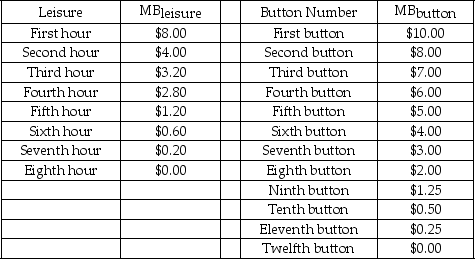Scenario: This problem applies the principle of optimization covered in Chapter 5 to the problem of choosing how many hours to work. Paul has to decide how many hours to work per day. His boss is willing to give Paul whatever hours Paul wants up to 8 hours. All else being equal, he would rather not work, that is, Paul has positive marginal benefit from each hour of leisure. But he is an avid collector of presidential campaign buttons. The more leisure he takes, the fewer buttons he can afford. So Paul faces a trade-off between leisure and buttons. Each button costs $1.00. The table below shows Paul's marginal benefits from leisure (MBlₑᵢsᵤᵣₑ) and buttons (MBbᵤttₒn) .

-Refer to the scenario above.If the hourly wage is $1.60,how many hours would Paul choose to work? How many buttons would he buy?
Definitions:
Position Acceptance
The act of agreeing to take a specific job or role that has been offered.
Expression of Thanks
A phrase or statement that shows gratitude or appreciation towards an individual or group for their actions or support.
Time Extension
An additional period given beyond the original deadline or schedule.
Specific Reasons
Detailed and explicit motives or explanations for a particular action, decision, or belief.
Q30: A green pasture has turned barren due
Q87: Refer to the scenario above.Suppose that,after the
Q96: Refer to the scenario above.Which of the
Q110: Refer to the scenario above.If the hourly
Q118: An employer discriminating against Asian workers is
Q125: Refer to the graph above.If the government
Q128: Labor demand is described as a derived
Q202: Refer to the scenario above.The deadweight loss
Q243: Which of the following statements correctly differentiates
Q248: For a firm with market power,the price